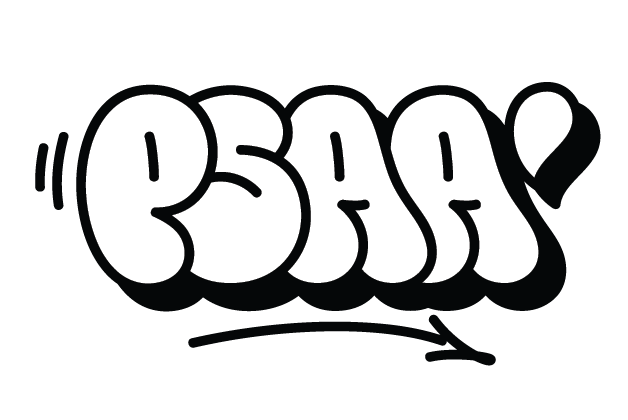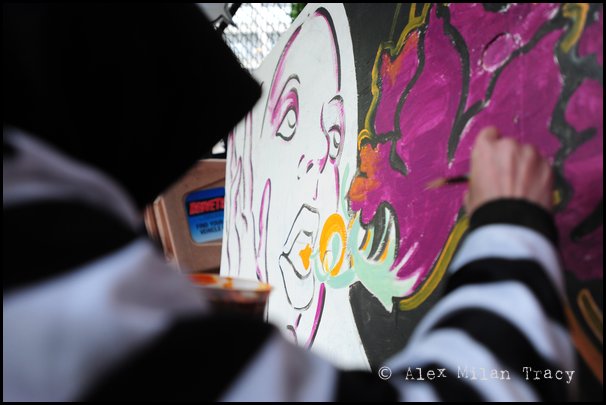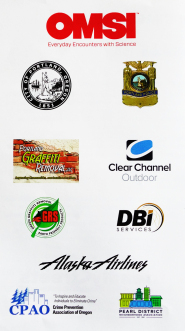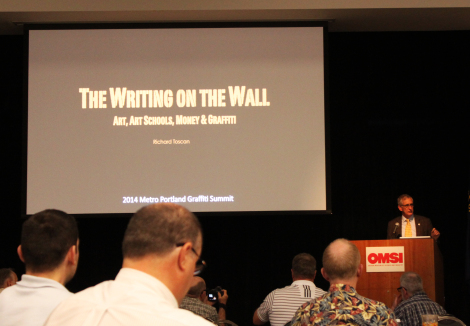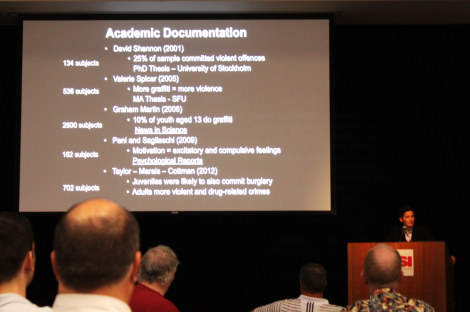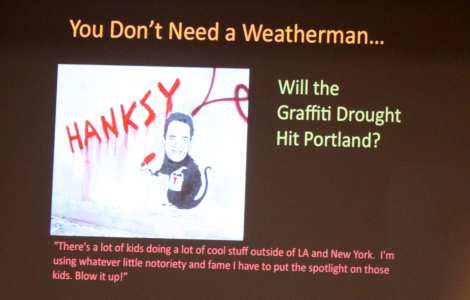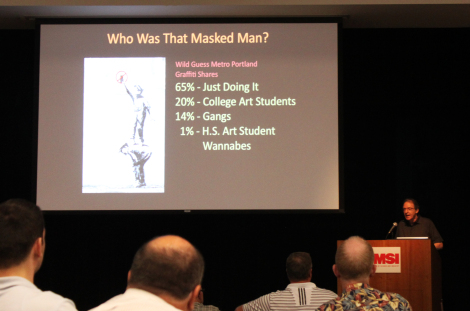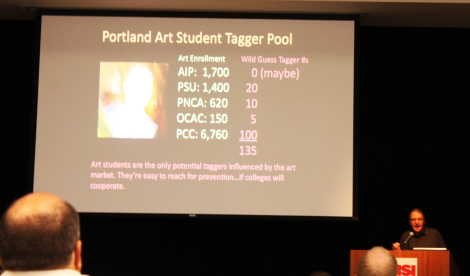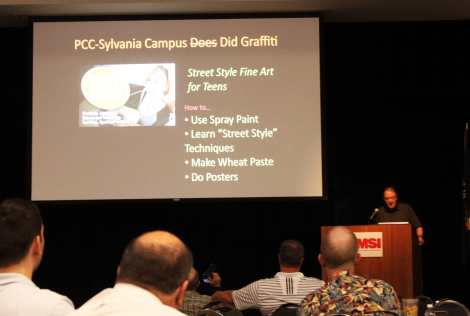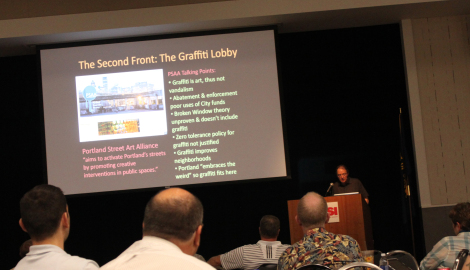For several years, members of PSAA have attended the annual Graffiti Abatement Summits, the region’s largest anti-graffiti event. An unlikely place for art advocates, but we hoped that by hearing opposing perspectives, we would gain a better understanding of the politics of graffiti criminalization and how the City of Portland approaches graffiti removal and abatement.
On May 23rd 2013, PSAA attended the 2013 Graffiti Abatement Summit held in Portland. This training was provided by Portland’s Graffiti Abatement Program (part of the Office of Neighborhood Involvement) for local officials, police officers, and community members interested in learning more about the topics of graffiti prevention, conviction, and removal.
Presentations were made by Portland’s Graffiti Police Investigator’s Matt Miller (Graffiti Vandals – Who They Are/Why They Do It) and Anthony Zanetti (Building a Case – How You Can Help), Multnomah County’s DDA Nathan Vasquez (Prosecuting Graffiti Cases), and Graffiti Abatement Coordinator Dennis LaGiudice (Abating Graffiti with Volunteers) along with a graffiti removal demonstration by the Graffiti Removal Services Corporation.
One of the main topics discussed at the Summit, was how to build felony cases against people caught doing unauthorized graffiti. For this reason, outside the building where the Summit was held, a group of local artist advocates staged a community action protest, spray-painting murals while dressed in black-and-white prison uniforms. These advocates wanted to call attention to the general criminalization of graffiti and street artists in Portland.
During Officer Matt Miller’s presentation, an audience member voiced their concerns about the lack of support for emerging artists, and the harassment of local businesses that support street art culture and graffiti-style art (the now closed Samo Lives & Railyard art galleries). This passionate outcry was met with some anger from the audience, and hostility from the presenter. The audience member was eventually escorted out by police.
Shortly after the interruption inside the Summit, three Portland Police officers arrived outside, at the community demonstration to question the group’s intentions. The police eventually left, making no arrests or demands.
Graffiti is often a symptom or sign of larger systemic societal issues, such as youth disenchantment, the privatization of public space, general resistance of mainstream and state-run systems, and the exclusiveness of the art establishment. There is a big difference in the intentions behind vandalism, gang graffiti, and ‘artistic’ expressions in the street – there are also differences in the outcomes and public acceptance of these different forms of spatial interventions.
Even though the City’s Graffiti Program Officer’s presentations focused on tagging as the main problem in the city, their actions over the past few years (which are based on a zero-tolerance graffiti policy) suggest that they often do not distinguish between various forms of unauthorized expression. Unfortunately, the Summit presentations seemed to instigate a ‘culture of fear’ and intolerance and promote broad stereotyping of people who carry out unauthorized public expression in the streets. Matt Miller clearly stated that these are “bad people,” who often commit violent crimes, have no respect for the community or authority, are gang members, and drug addicts.
Instead of making broad-brush stereotypes and promoting punitive policies, PSAA would like to see our city’s Graffiti (Abatement) Program provide more unbiased evidence-based information, educate the public about why graffiti actually exists and consider alternative graffiti management strategies that have shown positive outcomes in other cities (like Tacoma’s city-sponsored Graffiti Garages).
Additionally, graffiti police investigators should focus their resources on gang and hate graffiti (which they claim is the problem) and less on abating other forms of unauthorized (or unpermitted) artistic expression.
PSAA hopes that the Summit, and the subsequent reactions it sparked from the arts community, alerts Portlanders that it’s time to have a more open and inclusive dialogue about public expression in our city. This issue goes far beyond some random markings; it speaks to larger social questions about how we can better share and maintain our public spaces and how the community can engage in, and affect, public policy regarding these topics.
On Tuesday May 20th 2014, PSAA attended the 2014 Metro Portland Graffiti Summit. Hosted by the City of Portland and Friendly Streets, the Summit is organized by the Office of Neighborhood Involvement (ONI), the Graffiti Abatement Program (GAP), and the Portland Police Graffiti Task Force (GTF).
This event was also sponsored by several private, public and non-profit entities (including Clear Channel, Pearl District Neighborhood Association, various graffiti removal and management services, Alaska Airlines, and the Crime Prevention Association of Oregon).
The Summit Planning Committee consisted of Matt Miller and Anthony Zanetti (Portland Police Graffiti Task Force), Denay Love (Friendly Streets), Amy Archer (City of Portland), Dennis LaGiudice (City of Portland, Graffiti Program Coordinator) and Marcia Dennis (former City Graffiti Program Coordinator, now Vice President of Friendly Streets).
Starting this year, the Summit was divided into two sessions. First, a private day-long police training, and second, a free 3-hour public lecture and award session.
According to Friendly Streets, the first session provided “networking between police agencies” across the US and was designed as a “tool in catching and prosecuting graffiti vandals, who often travel between states to damage property.”
The second session included visiting and local guest speakers, City officials, neighborhood association members, and graffiti removal businesses. Even Portland Mayor Charlie Hales made a brief appearance to present ONI’s Graffiti “All-Star Awards.” Unfortunately, this session opened with a statement telling the audience that this was not the time for public comment, an obvious reference to last year’s public disturbance.
The keynote speech was given by Valerie Spicer, a Vancouver, BC police officer. A presentation focused on “Tagger Behavior and Graffiti Culture.” Spicer is a PhD candidate in criminology and holds master’s degrees in art history and criminology. She is also is the co-founder of RestART, a restorative art program that engages with graffiti offenders to build self-esteem and direct them towards “pro-social activities” like community mural painting.
Spicer presented her research on graffiti subcultures and juvenile risk predictors. Her main argument was that graffiti is an at-risk youth indicator and leads to serious social-ills like drug abuse, theft, and violence. Spicer believes that the motivations behind graffiti are usually to vandalize and destroy, and not making art. Spicer sees graffiti as the only supposed “art” movement that produces a victim, and thus needs to be criminalized.
An aesthetical argument was also put forth as Spicer went through photos of fine artists’ work (such as Picasso and Monet), and compared those to the artwork of graffiti taggers at the same age. Her key argument was that the “quality” of work by the graffitists was inferior to that of fine artists.
Spicer did present some empirical data from larger studies, like that of Graham Martin (2003), who argued that if society really wants to reduce graffiti, it has the responsibility to address the underlying socio-economic issues causing graffiti and should not just criminalize the outcome. Graham believes these issues should be addressed through preventive approaches and proactive programs, not with increased penalties and criminalization.
Taking just one audience question, Spicer was asked: Do stricter laws result in less graffiti? Spicer said that in Australia and Canada (where her research is focused), current data suggests that harsher penalties do not deter graffiti.
The next speaker was Richard Toscan, a retired art school Dean from Virginia Commonwealth University who helped create downtown Portland’s Cultural District.
Toscan’s presentation, titled “The Writing on the Wall: Art, Art Schools, Money and Graffiti,” touched on a number of topics, including the Spraycopter (a DIY graffiti-spraying drone), the Pearl District’s Centennial Mills water tower (AKA Portland’s unofficial graffiti museum), and his personal quest to convince the Portland Art Museum not to sell the “Guerilla Art Kit” book.
Providing his overview of graffiti art cultures, Toscan focused on street artists who also attend art school. Toscan gave several self-proclaimed “wild guesses” of who might makeup Portland’s “Tagger Pool.” He guessed that there are currently 700 taggers in Portland, 20% of those are “art school students,” and 1% are just “art-school-wannabees.” Toscan’s opinion-statistics went as far as estimating how many graffiti writers come from each of Portland’s universities and colleges.
Toscan then called out several Portland street art and graffiti related organizations and initiatives. Included in his list, was the Portland Street Art Alliance, labeled the “The Second Front: The Graffiti Lobby.”
Toscan told the audience to ignore PSAA’s mission statement (describing it as meaningless academic jargon) and explained that what PSAA is really doing is promoting crime, destruction, and vandalism. Toscan went on to suggest that PSAA was consorting with the Regional Arts and Culture Council (RACC) and will soon receive operational funding from them.
The final presentation was provided by Paul Watts of Graffiti Removal Services. Watts is also a board member of Friendly Streets. It is clear that one of the main functions of these summits is to provide a marketing venue for profit-seeking graffiti clean-up companies.
To clarify some of these misconceptions about PSAA…
For two years, PSAA has worked to build bridges and relationships within the city. We want to help promote all forms of public art in Portland.
RACC has been willing to meet with PSAA and listen to our concerns, ideas, and suggestions. We are concerned that Toscan suggested, in a public setting hosted by the City’s Graffiti Program, that community groups like PSAA should not be associated with. Isn’t it the duty of all public entities to be willing to meet with and at least try to understand the communities they represent and serve?
PSAA is open to speak to anyone who wants to know more about our mission and purpose. We have requested meetings with various representatives from the City over the past two years. To date, our requests have been mostly ignored.
As of 2013, PSAA is a volunteer-run community group. We do not make any money advocating for public art. We are open to opportunities for receiving city and/or private funding for specific art projects (such as murals, curated walls, etc.).
PSAA exists because we feel passionately about the public’s right to free speech, public space, and the city. We see these rights as essential ingredients for preserving a democratic society.
In general, PSAA does not believe that graffiti is an automatic sign of urban decay or distress. Like everything, it is place-specific and the larger context and intent should always be taken into account. We see the vast majority of graffiti in Portland as a sign of urban vitalization, vibrancy, energy, and urban culture-building. We also appreciate the history of graffiti and hip hop culture and recognize it as a valid form of self-expression.
It was unprofessional and irresponsible of the City of Portland to host this event without verifying whether or not its content was accurate. Toscan’s “wild guess” statistics are now being repeated in news articles, including one by Don MacGillivray recently published in the SE Examiner. If the Summit is going to host presentations by academics, they should at least be presenting legitimate statistics.
Commendably, this year’s Summit presented a few alternatives to simply criminalizing graffiti artists, such as the RestART program. However, we are disheartened to hear that Portland’s Graffiti Program is not using their funding to re-instate the mural-assistance program that was cut a few years ago.
We encourage everyone to contact their neighborhood and City representatives, and share your thoughts. We’ve been told the commissioners and neighborhood association presidents are good people to start with. Leaving your mark in public can have an effect, but speaking directly to those in power can have quite an impact too.
